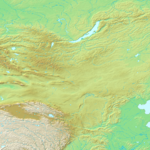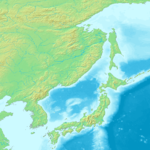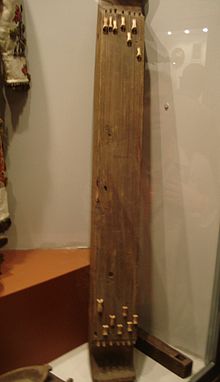- Indigenous peoples of Siberia
-
TaklamakanHindukush
Physical map of Northern Asia.  Siberia within the Russian Federation: Geographic Russian Siberia in light red, political Siberian Federal District in dark red
Siberia within the Russian Federation: Geographic Russian Siberia in light red, political Siberian Federal District in dark red
Including the Russian Far East, the population of Siberia numbers just above 40 million people. As a result of the 17th to 19th century Russian conquest of Siberia and the subsequent population movements during the Soviet era, the demographics of Siberia today is dominated by native speakers of Russian. There remain a considerable number of indigenous groups, between them accounting for below 10% of total Siberian population. Many of the individual groups are close to extinction[citation needed], or in the process of assimilation ("Russification").
Contents
Overview
Further information: Uralo-Siberian languagesClassifying the diverse population by language, it includes speakers of the following language families (number of speakers reflect the 2002 Russian census):
- Uralic
- Yukaghir (nearly extinct)
- Turkic [1][2]
- Yakuts (456,288 speakers)
- Dolgans (population: 7,261; speakers: 4,865)
- Tuvans (population: 243,442; speakers: 242,754)
- Tofa (population: 837; speakers: 378)
- Khakas (population: 75,622; speakers: 52,217)
- Shors (population: 13,975; speakers: 6,210)
- Chulyms (population: 656; speakers: 270)
- Altay (some 70,000 speakers)
- Mongolic (some 400,000 speakers)
- Tungusic (some 80,000 speakers)
- Yeniseian
- Ket (some 1,400 speakers)
- Chukotko-Kamchatkan (some 25,000 speakers)
- Nivkh (some 5,000 speakers)
- Eskimo–Aleut (some 2,000 speakers)
Simplified, the indigenous peoples of Siberia listed above can be put into four groups,
- Uralic
- Altaic
- Yeniseian branch of the Dené–Yeniseian languages
- Paleosiberian ("other")
Altaic has not been proven to be a language family, a phylogenetic unit. It may be a Sprachbund. Paleosiberian is simply a geographic term of convenience. Here, these two terms are listed just to serve as portal-like starting points – without suggesting genetic considerations.
Uralic group
Ugric peoples
The Khanty (obsolete: Ostyaks) and Mansi (obsolete: Voguls) live in Khanty-Mansi Autonomous Okrug, a region historically known as "Yugra" in Russia.
Samoyeds
Further information: Samoyedic peoplesSamoyedic peoples include:
- Northern Samoyedic peoples
- Southern Samoyedic peoples
Yukaghir
The Yukaghir (self-designation: одул odul, деткиль detkil) are people in East Siberia, living in the basin of the Kolyma River. The Tundra Yukaghirs live in the Lower Kolyma region in the Sakha Republic; the Taiga Yukagirs in the Upper Kolyma region in the Sakha Republic and in Srednekansky District of Magadan Oblast. By the time of Russian colonization in the 17th century, the Yukagir tribal groups (Chuvans, Khodyns, Anauls, etc.) occupied territories from the Lena River to the mouth of the Anadyr River. The number of the Yukagirs decreased between the 17th and 19th centuries due to epidemics, internecine wars and Tsarist colonial policy. Some of the Yukagirs have assimilated with the Yakuts, Evens, and Russians. Currently Yukagir live in the Yakut-Sakha Republic and the Chukchi Autonomous region of the Russian Federation. According to the 2002 Census, their total number was 1,509 people, up from 1,112 recorded in the 1989 Census).
Turkic peoples
Further information: Siberian TatarsThe most important examples for Shamanism in Siberia are Siberian Tatars, Yakuts, Dolgans and Tuvans.
Mongolic group
Main article: BuryatsThe Buryats number approximately 436,000, which makes them the largest ethnic minority group in Siberia. They are mainly concentrated in their homeland, the Buryat Republic, a federal subject of Russia. They are the northernmost major Mongol group.[3]
Buryats share many customs with their Mongolian cousins, including nomadic herding and erecting huts for shelter. Today, the majority of Buryats live in and around Ulan Ude, the capital of the republic, although many live more traditionally in the countryside. Their language is called Buryat.
Tungusic group
Further information: Tungusic peoplesThe Evenks live in the Evenk Autonomous Okrug of Russia.
"Paleosiberian" group
Main article: Paleosiberian languagesFour small language families and isolates, not known to have any linguistic relationship to each other, compose the Paleo-Siberian languages:
- 1. The Chukotko-Kamchatkan family, sometimes known as Luoravetlan, includes Chukchi and its close relatives, Koryak, Alutor and Kerek. Itelmen, also known as Kamchadal, is also distantly related. Chukchi, Koryak and Alutor are spoken in easternmost Siberia by communities numbering in the thousands. Kerek is close to extinction, and Itelmen is now spoken by fewer than 100 people, mostly elderly, on the west coast of the Kamchatka Peninsula.
- 2. Yukaghir is spoken in two mutually unintelligible varieties in the lower Kolyma and Indigirka valleys. Other languages, including Chuvantsy, spoken further inland and further east, are now extinct. Yukaghir is held by some to be related to the Uralic languages.
- 3. Ket is the last survivor of a small language family on the middle Yenisei and its tributaries. It has recently been convincingly demonstrated [1] to be related to the Na-Dene languages of North America. In the past, attempts have been made to relate it to Sino-Tibetan, North Caucasian, and Burushaski.
- 4. Nivkh is spoken in the lower Amur basin and on the northern half of Sakhalin island. It has a recent modern literature and the Nivkhs have experienced a turbulent history in the last century.
Culture and customs
 Laminar armour of hardened leather enforced by wood and bones worn by the indigenous peoples of Siberia and the Eskimo people
Laminar armour of hardened leather enforced by wood and bones worn by the indigenous peoples of Siberia and the Eskimo people
Literature
- Rubcova, E.S.: Materials on the Language and Folklore of the Eskimoes, Vol. I, Chaplino Dialect. Academy of Sciences of the USSR, Moskva * Leningrad, 1954
- Menovščikov, G. A. (= Г. А. Меновщиков) (1968). "Popular Conceptions, Religious Beliefs and Rites of the Asiatic Eskimoes". In Diószegi, Vilmos. Popular beliefs and folklore tradition in Siberia. Budapest: Akadémiai Kiadó.
- Barüske, Heinz: Eskimo Märchen. Eugen Diederichs Verlag, Düsseldorf and Köln, 1969.
- Merkur, Daniel: Becoming Half Hidden / Shamanism and Initiation Among the Inuit. Acta Universitatis Stockholmiensis / Stockholm Studies in Comparative Religion. Almqvist & Wiksell, Stockholm, 1985.
- Kleivan, I. and Sonne, B.: Eskimos / Greenland and Canada. (Series: Iconography of religions, section VIII /Arctic Peoples/, fascicle 2). Institute of Religious Iconography • State University Groningen. E.J. Brill, Leiden (The Netherland), 1985. ISBN 90-04-07160-1.
See also
- Demographics of Siberia
- First All Union Census of the Soviet Union
- Indigenous people
- List of ethnic groups
- Y-DNA haplogroups in Central and North Asian populations
- Pomors
- Kola Norwegians
- Uralic languages
- Shamanism in Siberia
- List of indigenous peoples of Russia
- List of small-numbered indigenous peoples of Russia
- Small-numbered indigenous peoples of Extreme North
References
- ^ http://www.perepis2002.ru/ct/doc/English/4-1.xls Russian Federation 2002 census; National Composition of Population and Citizenship
- ^ http://www.perepis2002.ru/ct/doc/English/4-4.xls Russian Federation 2002 census; Knowledge of Languages (except Russian)
- ^ The New Encyclopædia Britannica, 15th Edition. (1977). Vol. II, p. 396. ISBN 0-85229-315-1.
External links
- Russian Association of Indigenous Peoples of the North
- UNESCO Red Book on endangered languages: Northeast Asia
- Endangered Uralic Peoples
- Minority languages of Russia on the Net
- The Red Book of the peoples of the Russian Empire
- Survival International page on the Siberian Tribes
- L'auravetl'an Indigenous Information Network by Indigenous Peoples of Russia
- (Russian) В погоне за малыми, an article about treatment of minorities in the Russian Empire, Kommersant-Money, October 25, 2005
Indigenous peoples of the world by continent Indigenous peoples by geographic regionsCategories:- Ethnic groups in Russia
- Indigenous peoples of North Asia
- North Asia
- Northeast Asia
- Russian Far East
- Siberia
Wikimedia Foundation. 2010.











